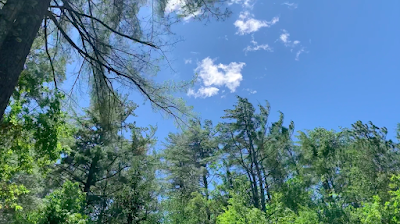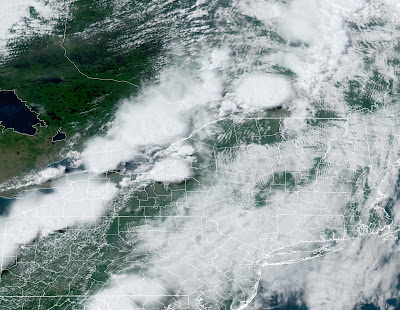 |
| A non-severe thunderstorm with a shelf cloud along its leading edge looking northwestward from St. Albans late Wednesday afternoon. |
So Wednesday afternoon turned into an unexpected delight as a weak cold front caused a bit more excitement than early forecasts indicated.
Thunderstorms erupted ahead and along the cold front in Vermont Wednesday afternoon and evening, creating some "safe" drama.
I keep remarking about our current Goldilocks summer, not too hot, not too cold. We even had Goldilocks thunderstorms yesterday. Fun to look at, but not particularly dangerous.
There's a couple photos of the storms in this post, and be sure to watch the video I shot at the bottom of this post.
There had been a low risk that a few of Wednesday's storms could have briefly strong, damaging winds. However, I've seen no reports of any storm damage. Vermont Outage Map last evening had 4,500 Vermont customers without power. I'm guessing that had to do with lightning strikes, or an isolated falling tree on a power line, probably in northeastern Vermont where one storm got a little rambunctious.
Radar images showed some storms briefly getting strong, but they would then quickly weaken. So, there might have been isolated pockets of fallen branches that either nobody saw or nobody reported. I drove through a fairly strong storm in Sheldon. My guess is peak gusts with that storm were a reasonable 35 mph or so.
I noted just one fallen small, roughly foot 18 long branch in the middle of Route 105 and another, rotten, ten foot long branch from a very dead tree on the side of the road. That branch would have probably fallen on a sunny, breezy day so it doesn't count.
 |
| Turbulent skies over Sheldon, Vermont late Wednesday afternoon as thunderstorms passed through the area. |
They often look incredibly ominous and scary, but the clouds themselves aren't a danger. People sometimes confuse them with incipient tornadoes but they definitely are not.
A shelf cloud often, but not always means the storm coming is severe, so it's best to seek shelter when you see one. Wednesday's shelf clouds were not attached to anything too dangerous, as we noted.
Rainfall wasn't even that impressive with most of the storms. Mostly because the air wasn't particularly humid, so the storms didn't have much moisture to work with. Montpelier reported just 0.17 inches of rain. Burlington had 0.05 inches. A brief downpour here in St. Albans yielded just a tenth of an inch.
We're heading into a holiday weekend, and the weather looks pretty favorable. The Goldilocks summer continues.
Today will be gorgeous, although some clouds from a dying complex of thunderstorms over the northern Great Lakes might throw some afternoon clouds our way.
Friday looks briefly hot, before another cold front sweeps through with showers Friday night and Saturday morning. Sunday and Monday look at this point at least partly sunny at this point, with temperatures a wee bit cooler than you'd expect on the Fourth of July. (Highs in the 70s, lows in the 50s) .
Here's some video I shot Wednesday of the non-violent but nice thunderstorms near St. Albans and Sheldon, Vermont. If you don't see the image of the video to hit, click on this link to view:




















